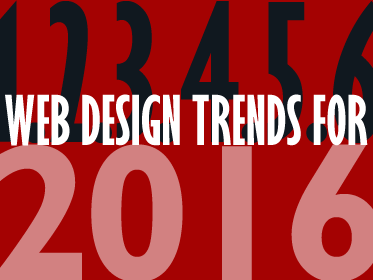While design fads come and go, recent web design trends are being driven primarily by mobile usability. If you are considering a new website now, you should be thinking about functionality and design that will continue to be effective into the future. Here are six web design trends that we believe will last.
Web Design Trends for 2016
 1. Responsive Design
1. Responsive Design
Perhaps the biggest trend is the increase in mobile-responsive design—a layout that adapts to fit different screen sizes. With the advent of Google’s new Mobilegeddon algorithm, mobile accessibility is a requirement for sites wishing to maintain search visibility and ranking.
A responsive web design can also change the way information is presented depending upon the device being used. If you’re the owner of a destination business, for example, you may want to feature a prominent clickable phone number and directions link at the top of your site. When a visitor is using a smart phone to browse your site, a quick touch can bring up a phone app, Google Maps, or even GPS directions.
2. Single Page Websites
Like responsive design, single page websites and infinite scroll pages provide an easy way for mobile visitors to view content. Links that stay “pinned” to the top of the screen and “back-to-top” buttons enable visitors to quickly navigate with one hand. While not suitable for every site, depending upon your business and content, a single page site is worth considering.
3. Card and Grid Layout
Call it the “Pinterest” effect if you like but, as website designs increasingly group content into movable blocks for a responsive layout, more sites are re-purposing this information for display elsewhere—a single post from a grid on a blog page might become a featured item or call-to-action on a home page. Content organized in blocks can also be easily shared on social networks.
4. Large Type
Another web design trend that has its roots in mobile-usability is the appearance of large type fonts. Not only are they easy to read regardless of whether you are using a laptop, tablet, or phone, large fonts provide a larger, more touch-friendly area for navigational elements or calls-to-action.
5. Mobile-friendly Menus on Desktop Sites
As mobile menu icons like the three horizontal bar “hamburger” icon become more familiar to users more desktop sites will adopt this approach. Rather than using an always-visible navigation bar, designs will incorporate icons that reveal navigation when selected.
6. Video and Kinetic Type
Video has been trending in website design for several years but, as online attention spans continue to decrease, video using kinetic typography is on the rise. Rather than simple captioning, animated type becomes an integral part of the video, drawing in the viewer while reinforcing the message even in a short clip.
Declining Website Design Trends
Sliders
Viewers rarely cycle through content-heavy slides, regardless of how engaging the images, and the code and the frequently horizontal orientations are not mobile-friendly.
Separate Mobile Sites or Themes
As more sites adopt a mobile-first responsive layout that fits any screen size, a separate mobile site or theme will no longer be necessary.
Downloadable Site Apps
Likewise, that bothersome “Would you like to download our app” pop-up message you see when browsing on a mobile device will disappear.
A website is an investment in time and money. Adopting a forward-looking approach now will ensure a site that will represent you well into the future.
